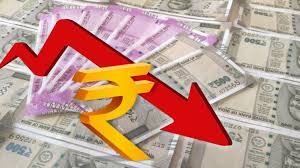
The Indian rupee fell past the 85 mark against the U.S. dollar for the first time on Thursday, reflecting growing pressure from both global monetary policies and domestic economic concerns. The decline comes on the heels of the U.S. Federal Reserve’s hawkish stance, signaling fewer interest rate cuts in 2025 than previously anticipated.
The rupee hit an intraday low of 85.0650 against the dollar, slipping from its previous close of 84.9525 on Wednesday. The speed of this depreciation highlights the growing vulnerability of the currency. It took the rupee just two months to drop from 84 to 85, a sharper decline compared to the 14 months it took to fall from 83 to 84.
Global Factors Weighing on the Rupee
The rupee’s decline mirrors a broader selloff in Asian currencies. On Thursday, the Korean won, Malaysian ringgit, and Indonesian rupiah fell by 0.8%-1.2%, driven by the Federal Reserve’s recent policy announcement. The Fed’s updated "dot plot" suggests just two rate cuts in 2025, half the number projected in September, bolstering the U.S. dollar’s strength.
Federal Reserve Chair Jerome Powell reinforced the central bank’s cautious approach, saying, “From here, it’s a new phase, and we’re going to be cautious about further cuts.” This sentiment has fueled a rally in the dollar, adding pressure to emerging-market currencies like the rupee.
Persistent dollar strength, partly driven by expectations of robust U.S. economic policies, has compounded challenges for India’s currency.
Domestic Economic Concerns
India’s domestic economic landscape has further exacerbated the rupee’s struggles. The country’s GDP growth slowed to a seven-quarter low during the July-September period, while the merchandise trade deficit continues to widen. Additionally, tepid capital inflows have hindered the rupee’s ability to recover.
Akshay Kumar, head of global markets at BNP Paribas India, noted that India’s slowing growth increases the likelihood of more aggressive rate cuts by the Reserve Bank of India (RBI). “In the short term, we can expect upward pressure on USD/INR to remain,” Kumar said, underscoring the challenges of stabilizing the rupee.
Investors have responded to these challenges by raising short positions on the rupee to a two-year high, according to a Reuters poll. The currency has weakened about 2% in 2024, placing it in the middle of the pack among Asian peers.
RBI’s Intervention and Future Volatility
The Reserve Bank of India has routinely intervened in foreign exchange markets to curb excessive volatility, which has helped maintain the rupee’s relative stability compared to other Asian currencies. However, analysts caution that such muted volatility may not persist in 2025, given the mounting headwinds.
The rupee’s current trajectory underscores the intersection of global monetary dynamics and domestic economic vulnerabilities. While the RBI’s interventions have provided short-term relief, structural issues like slowing growth and a widening trade deficit will likely require more comprehensive policy measures.
Looking ahead, the rupee’s path will depend on the balance between global pressures, such as the Federal Reserve’s policies, and India’s domestic economic strategies. For now, the currency remains under significant strain, with limited immediate relief in sight.
(Source:www.business-standard.com)
The rupee hit an intraday low of 85.0650 against the dollar, slipping from its previous close of 84.9525 on Wednesday. The speed of this depreciation highlights the growing vulnerability of the currency. It took the rupee just two months to drop from 84 to 85, a sharper decline compared to the 14 months it took to fall from 83 to 84.
Global Factors Weighing on the Rupee
The rupee’s decline mirrors a broader selloff in Asian currencies. On Thursday, the Korean won, Malaysian ringgit, and Indonesian rupiah fell by 0.8%-1.2%, driven by the Federal Reserve’s recent policy announcement. The Fed’s updated "dot plot" suggests just two rate cuts in 2025, half the number projected in September, bolstering the U.S. dollar’s strength.
Federal Reserve Chair Jerome Powell reinforced the central bank’s cautious approach, saying, “From here, it’s a new phase, and we’re going to be cautious about further cuts.” This sentiment has fueled a rally in the dollar, adding pressure to emerging-market currencies like the rupee.
Persistent dollar strength, partly driven by expectations of robust U.S. economic policies, has compounded challenges for India’s currency.
Domestic Economic Concerns
India’s domestic economic landscape has further exacerbated the rupee’s struggles. The country’s GDP growth slowed to a seven-quarter low during the July-September period, while the merchandise trade deficit continues to widen. Additionally, tepid capital inflows have hindered the rupee’s ability to recover.
Akshay Kumar, head of global markets at BNP Paribas India, noted that India’s slowing growth increases the likelihood of more aggressive rate cuts by the Reserve Bank of India (RBI). “In the short term, we can expect upward pressure on USD/INR to remain,” Kumar said, underscoring the challenges of stabilizing the rupee.
Investors have responded to these challenges by raising short positions on the rupee to a two-year high, according to a Reuters poll. The currency has weakened about 2% in 2024, placing it in the middle of the pack among Asian peers.
RBI’s Intervention and Future Volatility
The Reserve Bank of India has routinely intervened in foreign exchange markets to curb excessive volatility, which has helped maintain the rupee’s relative stability compared to other Asian currencies. However, analysts caution that such muted volatility may not persist in 2025, given the mounting headwinds.
The rupee’s current trajectory underscores the intersection of global monetary dynamics and domestic economic vulnerabilities. While the RBI’s interventions have provided short-term relief, structural issues like slowing growth and a widening trade deficit will likely require more comprehensive policy measures.
Looking ahead, the rupee’s path will depend on the balance between global pressures, such as the Federal Reserve’s policies, and India’s domestic economic strategies. For now, the currency remains under significant strain, with limited immediate relief in sight.
(Source:www.business-standard.com)














